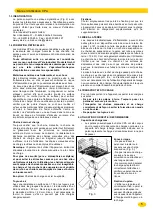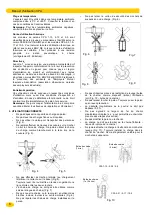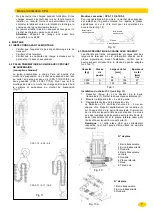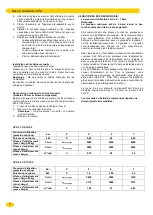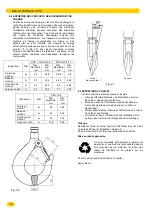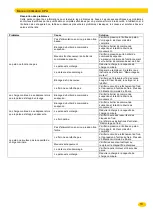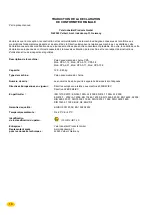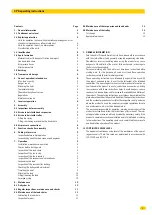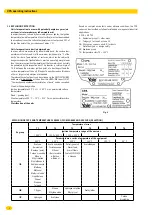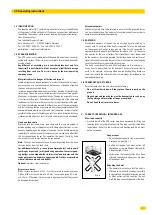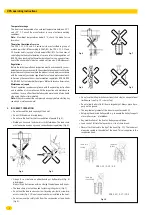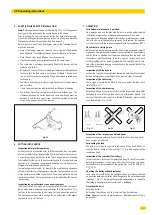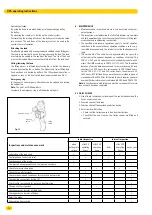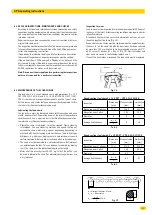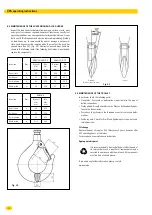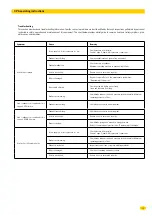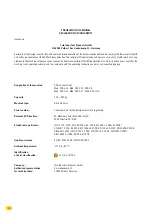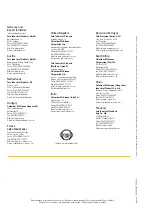
5
CPA operating instructions
2. CORRECT OPERATION / INTENDED uSE
Max. load capacity
• Air chain hoists of the CPA series have been developed for lifting and
lowering loads up to the rated capacity. The load capacity (rated load)
indicated on the hoist is the maximum safe working load which must
not be exceeded.
Danger zones
• Do not allow personnel to stay or pass under
a suspended load (Fig. 3).
• A lifted or clamped load must not be left
unattended or remain lifted or clamped for
a longer period of time.
• Start moving the load only after it has been
attached correctly and all persons are clear
of the danger zone.
Attaching the hoist
• The operator must ensure that the hoist is
attached in a manner that makes it possible
to operate the hoist without exposing himself
or other personnel to danger by the unit
itself, the load supporting device or the load.
1.3 IDENTIFICATION
The identity plate (Fig. 2) with all important data for exact identification
of the product is fitted on the hoist. If you have any questions with regard
to handling the product, which are not covered by the operating instruc-
tions, please contact:
Yale Industrial Products GmbH
Am Lindenkamp 31 – D-42549 Velbert, Germany
Tel.: +49-2051/600-600 – Fax: +49-2051/600-127
www.yale.de – email: [email protected]
1.4 SPARK FORMATION
The CPA series is only intended for lifting and lowering loads. In combi-
nation with trolleys, the hoists are also suitable for overhead horizontal
moving of loads.
Any different or exceeding use is considered incorrect and Yale
Industrial Products GmbH will not accept any liability for damage
resulting from such use. The risk is borne by the user/operating
company alone.
Materials subject to danger of friction and impact
Individual sparks can be generated as a result of frictional and/or impact
processes and, as a consequence can be the cause of dangers of ignition
in gases or impact-sensitive dusts.
Increased danger of ignition may emanate from clashing of special mate-
rial pairings. These are non corrosion-resistant steel or cast iron against
aluminium, magnesium or pertinent alloys. This applies especially in case
of rust (also surface rust). Especially at the friction points of the chain and
load hooks rust (surface rust) may occur. For correct operation of the prod-
uct it must therefore be ensured that there is no rust at these wear points
and that in the application area there are no material combinations of the
above-mentioned aluminium alloys and steel (exception: antirust steel) at
possible friction, impact or grinding points; thus spark formation by these
material combinations as a result of mechanical impact can be excluded.
Hand and load chain
Always ensure that hand chain, load chain and the load are guided to
exclude grinding and/or sliding contact with external constructions or com-
ponents. Depending on the degree of corrosion, the conductive discharge
capability of hand chains and/or load chains can worsen to an effect that
it is not adequate any longer. For operation this means that rusty hand
chains and/or load chains must no longer be used.
Note:
The user has to operate the unit to avoid sparking from the hand
chain as well as from the load chain.
For additional safety (e.g. in acetylene atmospheres) and to avoid
sparking by impact and/or friction during operation, the correspond-
ing trolleys are equipped with stainless steel hand chains and the
load and suspension hooks are copper-coated. Trolleys are provided
with solid bronze wheels and buffers.
Optional:
stainless steel load chains.
Air pressure hoses
With a surface resistance of > 10
9
Ω, air hoses used in explosion groups
I, IIA and IIB must have a dia. of ≤ 30 mm, in explosion group IIC, a dia.
of ≤ 20 mm. Otherwise, it is necessary to provide prove that they cannot
be dangerously charged.
Attachment points
Attachment points have to be selected to ensure that the expected forces
can be safely absorbed. The unit must move freely under load in order to
avoid impermissible additional loading.
1.5 EARTHING
Electrostatic dangers of ignition can be avoided by safe earthing. In
zones 1 and 21, earthing of the hoists is required. This can be obtained
via the suspension hook or suspension eye if the hoist is connected to
appropriately earthed parts (earth leakage resistance < 10
6
Ω). The same
also applies for the use of trolleys. Their travel beam must be earthed
by the customer. It must be ensured that trolley wheels and surfaces of
travel rails are not covered with coats of paint as otherwise earth leakage
resistance could reach inadmissibly high values.
The earth connection of the load hook is obtained via the load chain.
Loads have to be earthed, too, for transport. A separate connection to
earth is, for example, necessary when non-conducting lifting tackle are
used. In principle, the entire chain hoist must always be included in the
equipotential bonding.
1.6 TRANSPORT AND STORAGE
For safe transport of the unit, observe the following:
- Do not throw hoists down. Always place them properly on the
ground.
- Hand chains and load chains must be transported in such a way
that knotting and formation of loops are avoided.
- Do not bend the air pressure hoses.
Fig. 3

